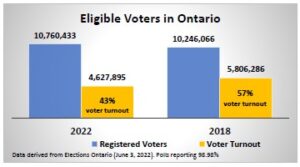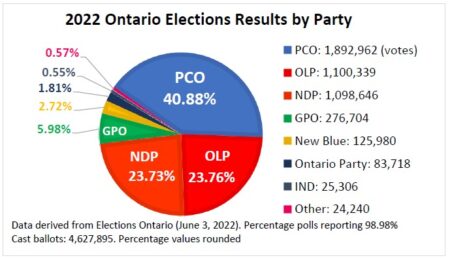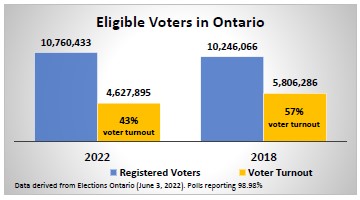The election results: failure to ignite the imagination?

TORONTO – The month of June has so far offered up an almost surreal political menu. On June 1, the Mayor of Vaughan closed off a self-indulgent birthday party, under the guise of a “spirit of generosity” event, to tell the City and all present that he had had enough of them all and was not going to seek re-election as Mayor.
The next night, in an unrelated event – the provincial election – citizens rewarded the PC party with a majority government, even though only 43% of the electorate decided to vote. The number of voters was even lower, only 33.5%, in the Premier’s home riding.
In Vaughan-Woodbridge (V-W), the home riding of the Liberal leader, there was a 44% voter turn out, but only 35% of them voted for him, preferring instead one of the lesser lights in Doug Ford’s government.
Province-wide, Liberals outperformed the NDP in percentage of popular vote 23.76% to 23.73% according to preliminary data from Elections Ontario. However, they were rewarded with only eight (8) seats while the NDP garnered 21. Nonetheless, in her own district, the NDP leader saw a voter turn-out of a mere 37.15%.
Contrary to what wokist, cancel culture commentators who rushed to friendly media to ascertain that the election results show that Ontario is progressive, there is another view. The definitive majority – 56% of all eligible voters who stayed away – disagree and expressed their aversion to both the ideology and its exponents by refusing to vote for what was on offer.
It is difficult to argue with the bald truth: the PCs ran a tactically astute campaign that produced the result they wanted. It is equally true that the other two parties “lost their way” and their usual supporters. The perception that the working-class and the Union-Movement is the patrimony of NDP dissipated, perhaps forever. Aside from white-collar public sector types, all the large labour unions avoided them like the plague.
The Liberals, long viewed as the Party of the “newer Canadians” and of the upwardly mobile entrepreneurial middle class, were shut out of their traditional strongholds – Including and especially in Vaughan Woodbridge, one of the wealthiest, most entrepreneurial areas of the country.
The community is a truly Canadian middle class and immigrant success story. It is rich in ethnic, religious, cultural and linguistic diversity.
One would have expected that economic and family issues to dominate the campaign. Yet the leader of the Liberal party chose to support one of his candidates next door, a trustee who has popularized the branding of Catholicism and Catholics as homophobic.
This in two constituencies where Italian Catholics represented the largest demographic segment. Both he and she were trounced. Catholics still comprise 33% of the population of Ontario. Other religious formations share their value structure. Italians make up one million of Ontario’s 14.5 million residents.
The Corriere Canadese, ran a series of 42 articles describing the constituencies where Italians numbered more than 8,000 residents or comprised more than 10% of the population. The Liberal s did not elect a single candidate from their ranks.
If there was ever an election to illustrate the Italian adage, “chi lascia la via vecchia per quella nuova sa quello che lascia ma non quello che trova” (loosely “better than devil you know…”), this would be the one.




